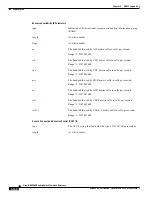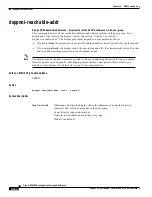
5-92
Cisco MGX 8850 Routing Switch Command Reference
Release 2.0, Part Number 78-10467-04 Rev C0, October 2001
Chapter 5
PNNI Commands
dsppnni-pkttrace
dsppnni-pkttrace
Display Packet Trace
—
display the parameters of a particular packet trace configuration.
This command applies to debugging only.
The dsppnni-pkttrace command displays the packet-trace settings. These settings are configured by the
cnfpnni-pkttrace command. You can use a packet trace to examine the contents of the PNNI Hello
packets that are exchanged between two neighboring peers.
Note
This command is very intrusive. If you execute it while the node carries live traffic, Cisco
recommends that you specify one direction at a time for the trace.
Cards on Which This Command Runs
PXM45
Syntax
dsppnni-pkttrace <rx | tx>
[node-index [ -portId port-id | -svcIndex svc-index]]
Syntax Description
tx | rx
Select a direction for the trace to display.
tx: transmit
rx: receive
node-index
In the current release, the only supported value for node-index 1. The node index
indicates the relative level of the logical node within a multi-peer group on the switch.
The range is 1–10, and the lowest level is 1.)
Range: 1–10
Default: 1
-portId
The port ID in this instance has the format of the logical ID number. The format is a
32-bit encoded number in the range 1–2147483648. If you do not have the port ID in
this form, use the dsppnport command and provide it with the common portID
format of slot[:subslot].port[:subport}. The output of dsppnport shows the logical
number for the port ID. Use this value is for the -portID parameter.
-svcIndex
An index of the switched virtual connection routing control channel (SVCC-RCC)
packet trace. This parameter is meaningful only if you specify node-index.
Default: none
Note
The current release does not support Routing Control Channels for
Switched Virtual Connections (SVCC-RCC), so this value must remain 0.
















































